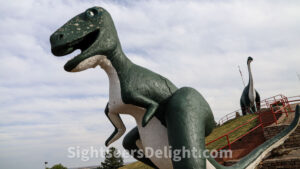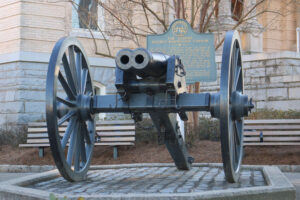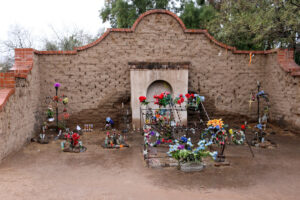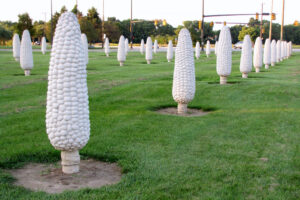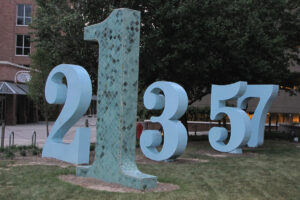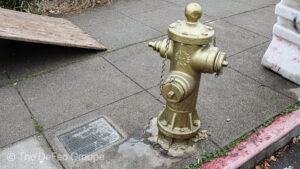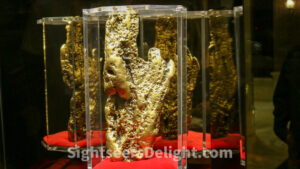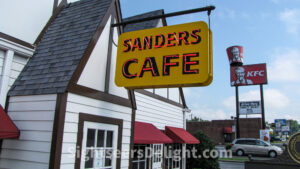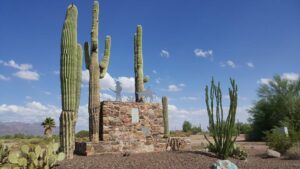Along Interstate 75 sits a definite oddity: a Titan missile. The missile, acquired from the Air Force in 1968 after it was declared obsolete, was flown from California to Warner Robins Air Base where it was stored for some time before it was given to the community. Titan I missiles were used between 1959 and 1965 and is considered the country’s first In-tercontinental Ballistic Missile (ICBM). The missile in Cordele stands on what has been dubbed Confederate Air Force Pad No. I.
In the 1930s, work began on Rapid City’s quirky and beloved Dinosaur Park. The idea originated after dinosaur bones and footprints were found in the area. The goal was to convince travelers to Mount Rushmore to visit Rapid City, hoping to change the area from a pass-through town to a must-stop destination. Sculptor Emmet Sullivan and his team used metal pipe frames, wire and concrete to build dinosaurs. Many workers who helped carve Mount Rushmore were hired for the project. Officials initially selected five dinosaurs, but the group expanded to seven when two smaller dinosaurs were added near the gift shop. In the 1950s, the dinosaurs, originally painted gray, were given their green and white color scheme.
The Double-Barreled Cannon was the brainchild of Dr. John Gilleland, a dentist from Jackson County, Ga., and a member of Mitchell’s Thunderbolts. Built in 1862 at the Athens Foundry and Machine Works, the Double-Barreled Cannon is today little more than a bookmark in history and a rather unique relic. The cannon was designed to fire two cannonballs connected by a chain so as to “mow down the enemy somewhat as a scythe cuts wheat.” According one account, the cannon was tested on a site along Newton Bridge Road, but since the two barrels did not have the same range, the chain broke in mid-air. According to some sources, one of the cannon balls killed a cow in a field nearby. According to a number of sources, including books and newspaper accounts, the cannon was not used in battle. But, according to a Confederate Veteran article, the cannon was used during a skirmish, but not as originally designed.
El Tiradito is a famous shrine in the Old Barrio section of Tucson. The memorial is said to be the only Catholic shrine in the country “dedicated to a sinner buried in unconsecrated ground.” According to one version of the legend, the monument honors Juan Oliveras, an 18-year-old ranch hand who had an affair with his mother-in-law. His father-in-law subsequently killed Oliveras. The original shrine dates to 1870, but the current version dates to 1920s. The shrine is said to exemplify Sonoran Catholicism, a blending of Catholic doctrine with local customs. The National Register of Historic Places added it to its list in 1971.
85701
Malcolm Cochran created “Field of Corn (with Osage Orange),” which debuted in 1994 and as part of a project commissioned by the Dublin Arts Council. The field features 109 rows of corn measuing six feet tall or taller. Sam Frantz, a pioneer of hybrid corn and his wife, Eulalia, previously owned the land and grew corn here. Since debuting, the project wasn’t without its share of controversy.
Arizona artist Barbara Grygutis created the Garden of Constants, located at the College of Engineering. The garden, installed in 2004, features two main elements: 10 large number sculptures numbers and symbols set into the pavement. The Ohio State University Percent for the Arts commissioned the sculpture. The work is located outside of Dreese Lab, home to the Computer and Information Science and Electrical Engineering departments.
43210
Two days after the massive earthquake of April 18, 1906, ruptured gas lines caused much of San Francisco to burn. Firefighters in many instances were unable to extinguish flames as fire hydrants had no water. However, firefighters vowed to make a stand at the intersection of Church and 20th streets. Miraculously, water flowed from a fire hydrant near the intersection and every April 18, the fire hydrant receives a new coat of gold paint.
94114
Located deep inside The Golden Nugget on Fremont Street is a golden nugget, one of the largest on display anywhere in the world. The “Hand of Faith” weighs an astonishing 61 pounds, 11 ounces. Kevin Hillier found the nugget near Wedderburn, Australia, in 1980. A year later, it made its way to the casino where it is on display for the world to see. The nugget — said to be the second largest ever discovered and the largest in existence — is valued at more than $3 million.
89101
Col. Harland Sanders played a pivotal role in the evolution of fast food dining. Before KFC was a staple of modern cuisine, he owned the Harland Sanders Café along U.S. Route 25 in Corbin, Ky. By the late 1930s, Sanders was well known for his culinary offerings, and by 1940 he opened a motel-restaurant complex here.
40701
Jacob Waltz could be called the ultimate wanderlust. According to legend, he discovered a great gold mine somewhere in the hills around Apache Junction, but the precise location was lost to history after he died in 1891. A monument in Apache Junction helps keep his story and the legend of the Lost Dutchman alive.
85120

